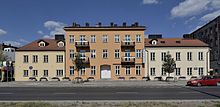Warsaw Praga Museum
The Warsaw Praga Museum (Polish: Muzeum Warszawskiej Pragi ) is the only museum in Warsaw to date on the right bank of the Vistula . It is dedicated to the history of Warsaw's Praga district . Temporary exhibitions are currently being held in the provisionally renovated rooms of the former “Koneser” vodka factory ( Ulica Ząbkowska 23/25 ); From 2014, a building ensemble currently undergoing renovation and conversion is to be moved into at Ulica Targowa 50/52 .
history
In 2006 the Warsaw City Council decided to set up a museum dedicated to the history of Praga. The term “Praga” is understood in a broader sense; it includes historical places and current districts such as Bródno, Białołęka , Gocław, Grochów, Kamionek, Saska Kępa, Skaryszew, Tarchomin, Targówek or Zerzeń. The museum is a branch of the Warsaw Museum ; the city of Warsaw is responsible for the financing.
Until moving into the future seat of the museum, exhibitions will take place in the rooms of the nearby former voda factory “Koneser”. For example, from May to September 2001, on the occasion of the 100th anniversary of the scouting movement in Praga, an exhibition on the history of this unit was shown. From October to December 2011, information was provided about the no longer used Protestant cemeteries in Białołęka. A historical photo exhibition on the recreational activities of the residents of Praga will take place from May to September 2012. The administrative rooms of the museum are also located here until further notice.
Future museum location
Three historical buildings attached to one another on the main road Targowa as well as a backyard with corresponding buildings will serve as the seat of the museum in the future. The location and the buildings themselves are closely linked to the history of the district. The well-known and historical bazaar market “Różycki”, which is also accessible from both sides of the museum, is immediately adjacent to the back yard. The row of houses on the Targowa consists (from north to south) of the Krzyżanowski building , the oldest brick house in the area from the late 18th century, the middle Sokołowski house from 1873 and the Rothblith house , which was built between 1829 and 1830 has been. The cellars of the two southern buildings are older, they also date from around the end of the 18th century. When the opposite Ulica Kępna was extended beyond the Targowa at the beginning of the 20th century , part of the Rothblith House had to be demolished.
There is an old outbuilding in the back yard. In addition, a modern administration and event building will be built here, which will close off the courtyard to the Kępna and the bazaar. The exhibition itself will be designed to be interactive. In addition to the display of historical workshops and a collection of icons , there will be spoken installations and a café. The museum is also intended to serve as a venue for local meetings and education, research, and art events.
Renovation and renovation
The row of houses will be gutted, completely renovated and rebuilt according to the museum requirements. The outbuilding in the courtyard is also being renovated. A roughly right-angled, three-storey new concrete building is being erected towards the Kępna and the bazaar. The renovation costs amount to 38 million złoty (about 9 million euros) and are co-financed by about a third from the Regional Development Fund (OPI & E) of the European Union. The completion and opening of the new museum is planned for 2014.
Synagogue (Ulica Targowa)
In the outwardly inconspicuous, historical outbuilding on the courtyard side there is a former synagogue . The building presumably dates from 1794, the Jewish prayer house was established here in 1869. A Jewish primary school was located in the building as early as 1839. The interior of the synagogue dates from 1873 and 1874; two interiors contain fragments of wall paintings uncovered in 1996. The polychromy includes signs of the zodiac from the Hebrew calendar as well as scenes from Jewish life (e.g. prayers at the Western Wall and Rachel's grave in Bethlehem ).
See also
References and comments
- ↑ a b Brochure Muzeum Warszawskiej Pragi w organizacji , Muzeum Historyczne m. st. Warszawy (Ed.), From around 2007.
- ↑ The market (Polish: Bazar Rózyckiego) was founded by Julian Józef Różycki at the end of the 19th century.
- ↑ a b Brochure Targowa 50/52. Unikatowe miejsce w sercu Starej Pragi , Muzeum Warszawskiej Pragi (ed.), Around 2008.
- ↑ Notice board at the construction site, see photo on the board .
Web links
Coordinates: 52 ° 15 ′ 6.1 ″ N , 21 ° 2 ′ 21.3 ″ E







